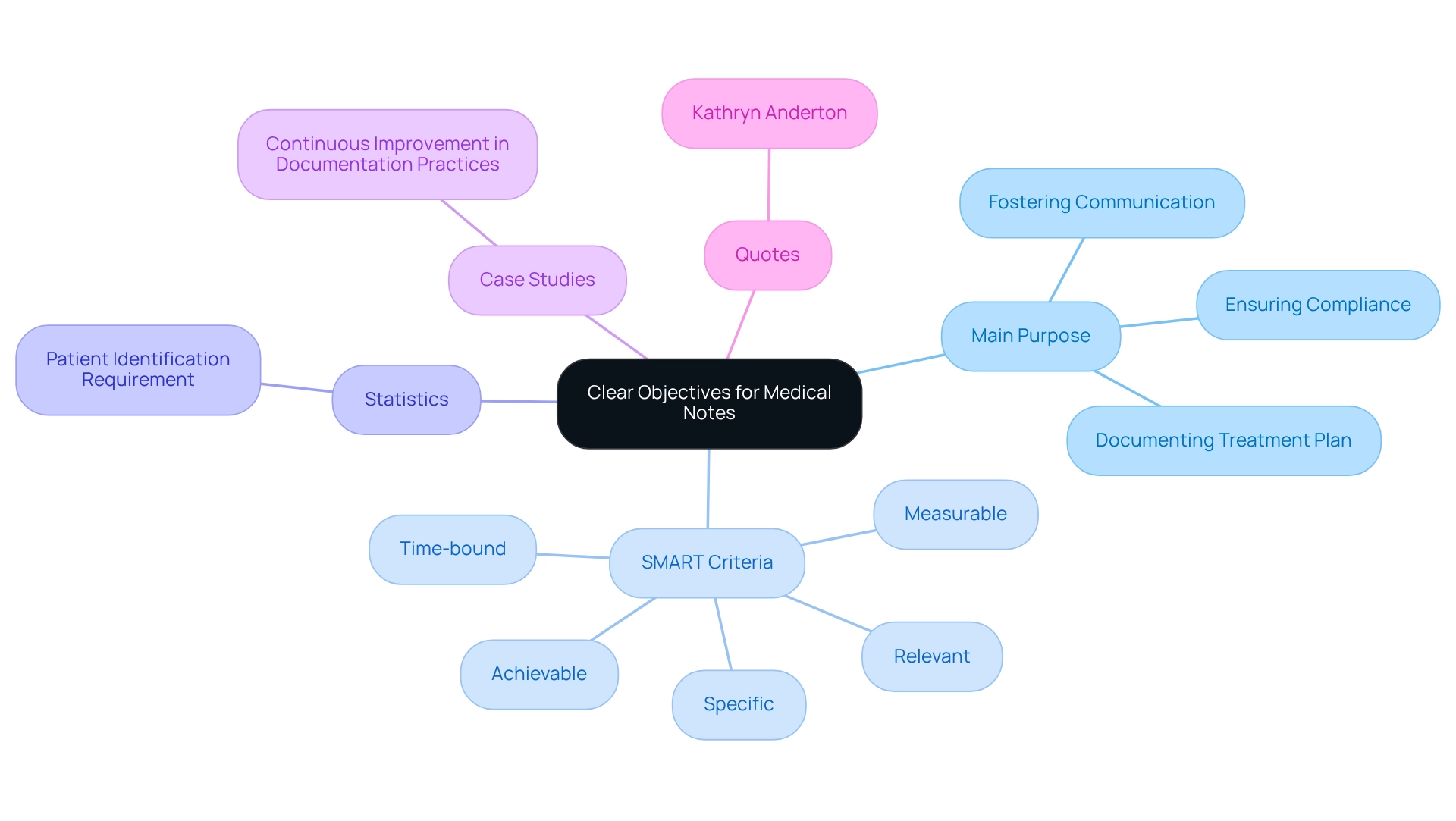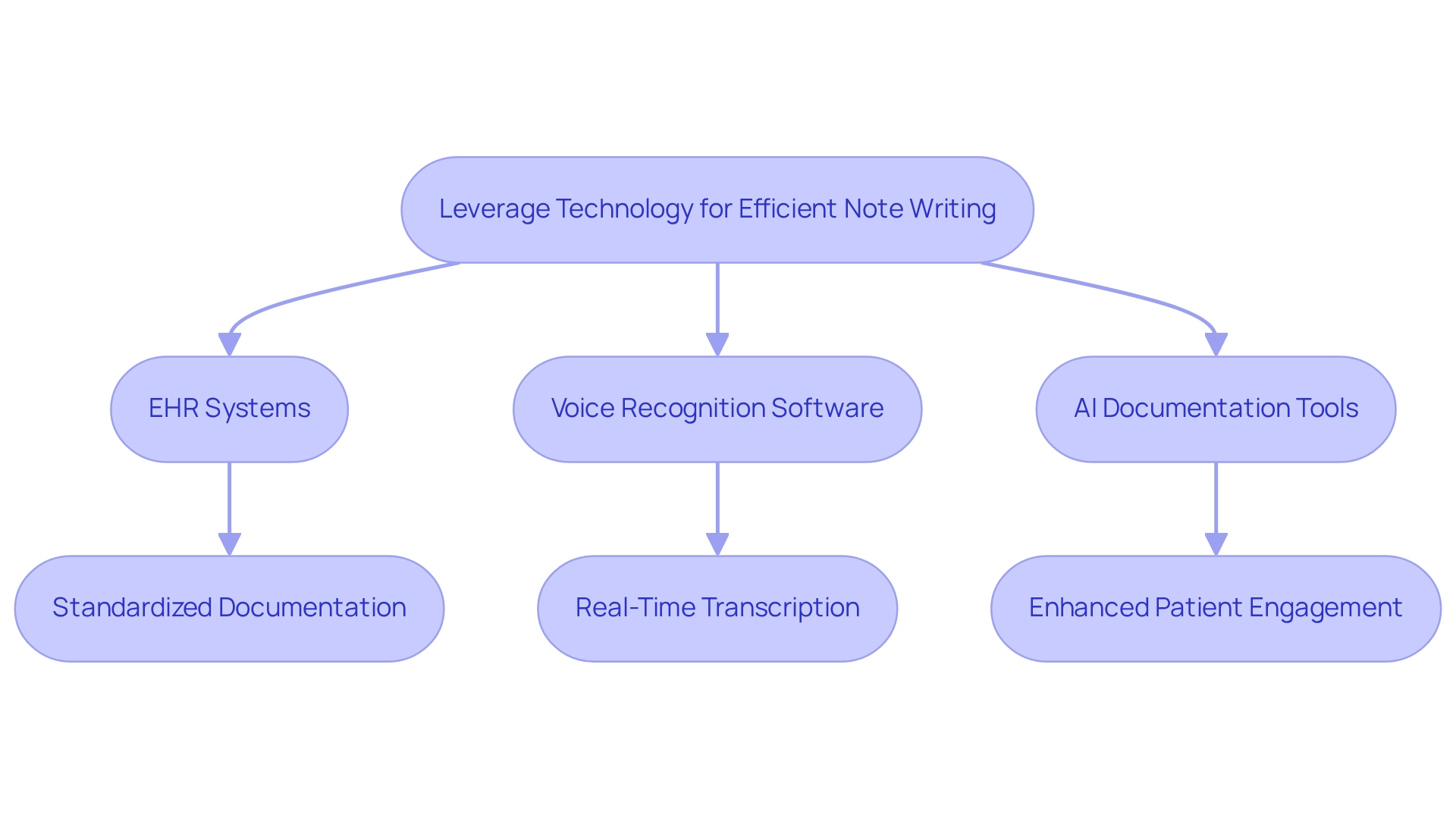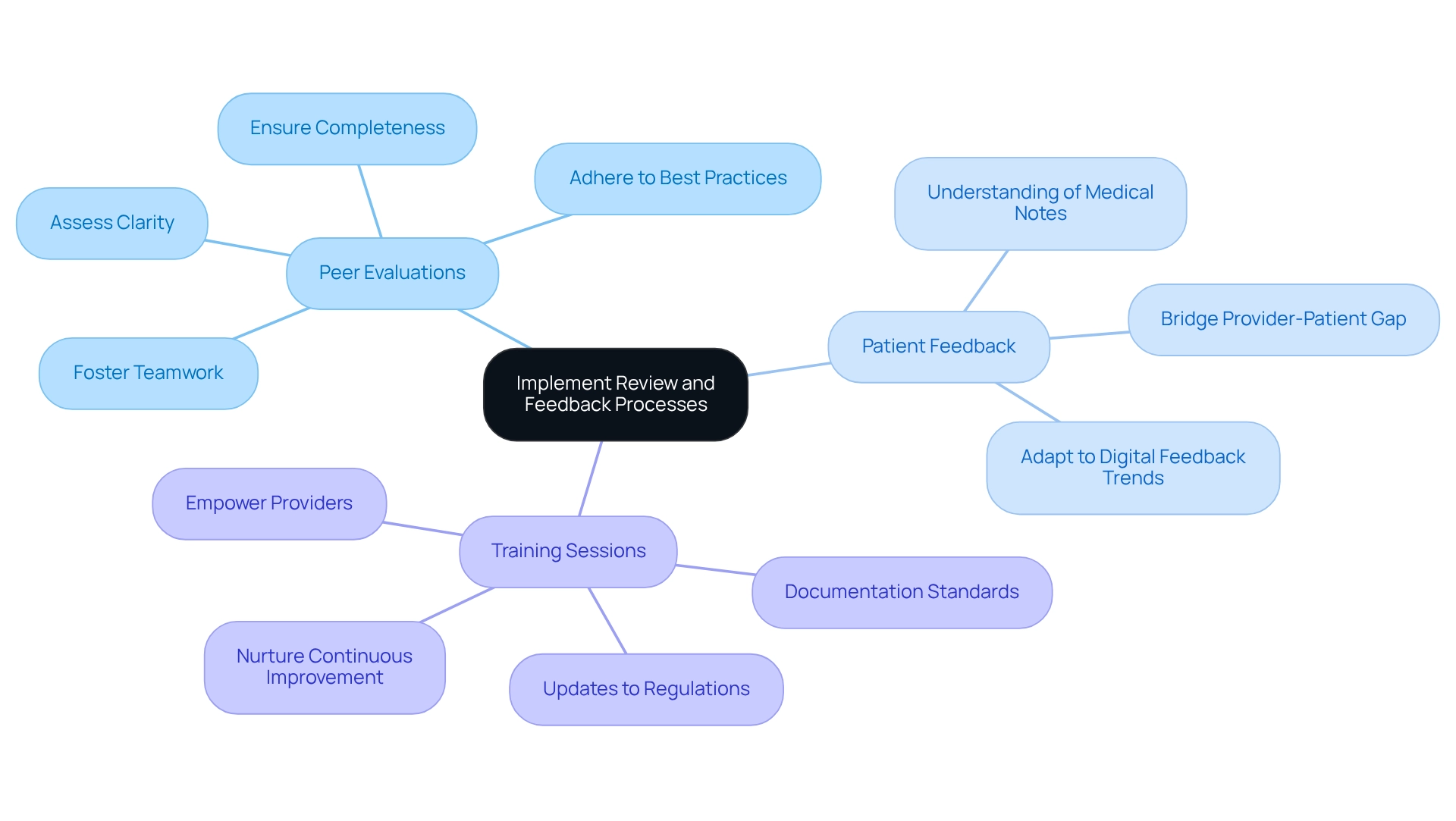Overview
In the demanding world of healthcare, writing effective medical notes can often feel overwhelming. Healthcare providers face emotional challenges that can impact their ability to deliver the best patient care. This article outlines four compassionate strategies designed to alleviate some of these burdens:
- Establishing clear objectives
- Incorporating essential elements
- Leveraging technology
- Implementing review processes
These strategies are not just theoretical; they are grounded in evidence that highlights the importance of structured documentation. By using advanced tools, healthcare providers can enhance their efficiency, allowing more time for patient interaction. Moreover, the inclusion of peer feedback fosters a collaborative environment, ultimately benefiting patient care and communication within healthcare teams.
Imagine a workplace where documentation is streamlined, and each note serves its purpose effectively. This is not just a dream; it can be a reality through the adoption of these strategies. As you reflect on your current practices, consider how these approaches can transform your workflow and support your commitment to patient care.
By embracing these strategies, you can take a proactive step towards improving not only your documentation but also the overall quality of care you provide. Let’s work together to create a more efficient and compassionate healthcare environment, ensuring that every patient receives the attention they deserve.
Introduction
In the intricate world of healthcare, effective communication is not just important; it is essential. Medical notes act as a vital bridge connecting providers and patients. As the landscape of patient care evolves, the emotional weight of crafting clear, comprehensive documentation becomes increasingly significant.
Have you ever felt overwhelmed by the administrative burdens that can impact patient care? This article explores essential strategies for writing impactful medical notes, focusing on how clear objectives, structured formats, advanced technologies, and continuous feedback can elevate the quality of documentation. By embracing these practices, healthcare professionals can enhance patient outcomes and streamline their workflows.
Imagine a more efficient, patient-centered approach to care—one where communication flows seamlessly, fostering trust and understanding. Let us delve into these strategies together, supporting each other in the journey toward better healthcare communication.
Establish Clear Objectives for Medical Notes
To compose effective medical records, writing medical notes requires starting with clear objectives that resonate with the heart of healthcare. Recognizing the main purpose of the note—whether it's writing medical notes to document a client interaction, fostering communication among healthcare professionals, or ensuring compliance with legal standards—sets the foundation for compassionate care. For example, if the goal is to document an individual's treatment plan, focus on including relevant details about their condition, the treatment options discussed, and the follow-up plans that will support their journey.
Utilizing the SMART criteria—Specific, Measurable, Achievable, Relevant, Time-bound—can guide you in formulating these objectives with care. A particular goal might be to document the individual's vital signs and any changes in their condition during the visit, ensuring these details are both quantifiable and relevant to their treatment plan. This approach not only ensures comprehensive notes but also aligns with the objectives of care and administrative efficiency, ultimately nurturing better patient outcomes.
Statistics reveal that healthcare providers must ensure patient identification and contact details are recorded in all medical records, underscoring the importance of clear objectives in this vital process. Additionally, case studies like "Continuous Improvement in Documentation Practices" highlight the necessity of ongoing training and periodic reviews of documentation strategies. Regular updates to these strategies can empower medical providers to remain compliant and effective in their record-keeping, fostering a supportive environment for both staff and patients.
As Kathryn Anderton, Vice President of Clinical Operations, wisely states, "The individual’s goals should drive care coordination, but to be effective, person-centered care management also requires effective communication and coordination among the individual, their medical providers as well as paid and unpaid supports." By focusing on effective goals for medical records, healthcare professionals can not only enhance the quality of their writing medical notes but also improve communication within the care team, leading to better outcomes for individuals. Together, let’s embrace these practices to create a more compassionate healthcare experience.

Incorporate Essential Elements in Documentation
Writing medical notes is an essential part of effective medical documentation for providing high-quality care to individuals. It’s important to recognize the emotional challenges healthcare providers face in managing their responsibilities. Incorporating key components such as individual demographics, medical history, current medications, allergies, and encounter details in writing medical notes can feel overwhelming.
However, utilizing a structured format like the SOAP (Subjective, Objective, Assessment, Plan) method for writing medical notes can significantly enhance clarity and comprehensiveness. Have you ever felt bogged down by administrative tasks? Automating processes like appointment scheduling and medical record management can further streamline your workflow, allowing you to concentrate more on delivering care rather than being burdened by paperwork. Statistics suggest that organized records can lead to a 30% improvement in the precision of medical files, which is vital for efficient treatment planning.
Moreover, case studies, including those from Relias Experience Management, demonstrate that focusing on client experience through careful record-keeping can improve satisfaction and strengthen the provider-client relationship. Experts advocate for the SOAP method, emphasizing its effectiveness in writing medical notes and structuring clinical documentation. This ultimately aids in improved clinical decision-making and patient outcomes through the effective writing of medical notes. By embracing these practices, you can foster a more compassionate and effective healthcare environment.

Leverage Technology for Efficient Note Writing
Healthcare providers often face emotional challenges that can weigh heavily on their ability to deliver optimal patient care. The administrative burdens associated with writing medical notes can detract from the time and attention they wish to devote to their clients. To help alleviate this stress, advanced technologies like Electronic Health Records (EHR) systems, voice recognition software, and AI-powered documentation tools from CosmaNeura can be invaluable for writing medical notes. By utilizing templates within EHRs, providers can standardize writing medical notes formats, which facilitates quicker and more consistent information entry. Imagine being able to transcribe interactions in real-time with CosmaNeura's AI tools, allowing you to maintain eye contact and engage more effectively with your clients. This integration not only reduces administrative burdens but also enhances the quality of documentation, ultimately leading to improved patient care outcomes.
Consider the impact: a study on a fuzzy logic system for predicting coronary artery disease demonstrated a remarkable classification accuracy of 99.61%. This showcases how technology can significantly aid clinical decision-making and support you in your daily practice. As the adoption of EHR systems continues to rise, with early-stage funding for EHR startups reaching $2.3 billion in 2023, the emphasis on data privacy and security—highlighted by recent EU regulations—underscores the importance of these tools in modern healthcare.
By embracing these technologies, you can not only enhance your efficiency but also foster a deeper connection with your patients. Isn't it time to explore how these solutions can support you in your vital work? Let's take the next step together towards a more efficient and compassionate healthcare experience.

Implement Review and Feedback Processes
In the demanding world of healthcare, introducing a systematic evaluation and response procedure can be a game changer for writing medical notes. Have you ever felt overwhelmed by the complexity of record-keeping? Implementing peer evaluations allows colleagues to support one another by assessing records for clarity, completeness, and adherence to best practices. This collaborative approach not only fosters teamwork but also enhances the quality of care provided.
Moreover, seeking feedback from patients about their understanding of medical notes can illuminate how effectively essential information is communicated. This insight is invaluable in bridging the gap between providers and patients, ensuring that everyone is on the same page. Regular training sessions on documentation standards and updates to regulations can empower medical providers, keeping them informed and engaged in improving their skills in writing medical notes. By nurturing a culture of continuous improvement, healthcare organizations can significantly enhance the overall quality of care. Imagine the difference it would make if every provider felt supported and equipped to excel in their documentation practices. Together, we can create an environment where both healthcare providers and patients thrive, leading to better outcomes for all.

Conclusion
Effective medical documentation is truly a cornerstone of quality healthcare. Have you ever felt overwhelmed by the demands of your role? By establishing clear objectives, healthcare providers can ensure that their notes serve specific purposes, such as documenting patient encounters or facilitating communication among care teams. Utilizing frameworks like the SMART criteria can aid in formulating these objectives, aligning documentation with both patient care goals and administrative requirements.
Incorporating essential elements into medical notes is equally important. The structured SOAP method not only enhances clarity but also supports comprehensive patient assessments. By automating administrative tasks and focusing on critical documentation aspects, healthcare professionals can streamline their workflows, ultimately improving patient care and satisfaction.
Imagine leveraging technology to further amplify the efficiency of note writing. Advanced tools like Electronic Health Records and AI-powered documentation systems can significantly reduce the administrative burden on healthcare providers, allowing them to concentrate more on meaningful patient interactions. The integration of such technologies not only enhances the quality of clinical documentation but also fosters better patient outcomes.
Lastly, implementing review and feedback processes cultivates a culture of continuous improvement in medical documentation practices. Peer reviews and patient feedback can provide invaluable insights, ensuring that healthcare providers remain aligned with best practices and regulatory standards.
In summary, prioritizing effective communication through improved medical documentation is essential for enhancing patient care. By embracing clear objectives, structured formats, advanced technologies, and a culture of feedback, healthcare professionals can create a more efficient, patient-centered approach to care. This commitment to excellence in documentation ultimately leads to better patient outcomes and a stronger healthcare ecosystem. How will you take action to enhance your documentation practices today?




